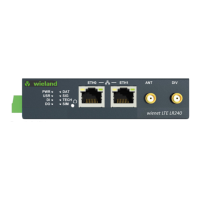
Do you have a question about the Wieland wienet LTE LR240 and is the answer not in the manual?
| Model | wienet LTE LR240 |
|---|---|
| Category | Wireless Router |
| LTE Support | Yes |
| Wi-Fi Frequency Bands | 2.4 GHz |
| Maximum Wi-Fi Speed | 300 Mbps |
| Antenna Type | External |
| Cellular Technology | LTE |
| Wi-Fi | Yes |
| Wi-Fi Standard | 802.11 b/g/n |
| Power Supply | 12V DC |
| Frequency Band | 2.4 GHz |
| Security | WPA2 |
Provides technical staff with information about the device, its functions, intended use, and technical data.
Lists downloadable product information, data sheets, and technical notes from the manufacturer's website.
Identifies intended users as trained personnel with basic knowledge of electrical installations.
Explains the meaning of DANGER, WARNING, CAUTION, and NOTE symbols for safety information.
Specifies requirements for using the equipment in Class I, Division 2 or ATEX Zone 2 environments for safety.
Provides essential safety notices for proper usage, handling, and avoiding damage or injury.
Describes the industrial cellular router's purpose, capabilities, and features like LTE Cat.4, VPN, and Linux platform.
Details the different versions of the wienet LTE LR240/241 router available based on hardware configuration.
Details the trade name, type name, and packaging format for product identification.
Shows an example of the product label with essential information like P/N, MAC, IMEI, and manufacturer details.
Lists the specific order codes for different router models and their features, including interfaces.
Provides a visual preview and brief description of the router's hardware components and their locations.
Lists the standard items included in the router package, such as the router itself and a DIN rail clip.
Presents detailed measurements of the router in millimeters, including with and without mounting clips.
Illustrates a basic network setup where the router connects a LAN to the internet via a mobile network.
Shows a configuration for redundant internet access using the router and potentially other routers.
Explains how to establish secure network connections using VPN tunnels for data protection.
Demonstrates the router's function as a serial gateway, connecting PLCs and SCADA systems to networks.
Provides guidelines on where and how to mount the router safely, considering environments and EMC.
Details the procedure for mounting the router onto a standard DIN rail using the provided clip.
Illustrates the step-by-step process for safely detaching the router from a DIN rail mount.
Explains the location, type, and insertion procedure for SIM cards required for mobile network operation.
Describes the SMA connectors for main and diversity antennas and precautions for their use.
Details the RJ45 Ethernet connectors, pinout, and isolation specifications for network connectivity.
Explains the power supply requirements, connection terminals, and grounding recommendations for the router.
Describes the binary input and output ports, their pinout, and functional connection schemes.
Details the RS485 and RS232 serial interfaces, their connectors, pinouts, and electrical isolation.
Explains the meaning of various LEDs on the router and Ethernet ports for status monitoring.
Details the procedures for rebooting, factory resetting, and emergency resetting the router using the RST button.
Describes the initial startup process when power is supplied and the router connects to the mobile network.
Guides on initial router setup via web browser, default IP, login, and security recommendations.
Lists key technical specifications including operating temperature, humidity, voltage, dimensions, and connectors.
Details the compliance of the router with various radio, EMC, safety, national, and environmental standards.
Outlines the type tests performed and the environmental conditions the router is tested against for reliability.
Provides detailed technical parameters for the cellular module, including supported frequencies and bit rates.
Specifies the electrical characteristics and web interface status for the router's binary input and output ports.
Lists the main system parameters, including CPU architecture, frequency, flash memory, RAM, and watchdog.